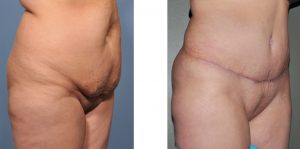Liposuction and abdominoplasty are two of the most popular plastic surgery procedures. While commonly used to treat different body areas, they can be combined to improve one’s abdominal contour and shape. When done together and weaved into a single procedure, it is known as lipoabdominoplasty or liposuction abdominoplasty.
A traditional abdominoplasty or tummy tuck involves removing lower abdominal skin and fat and undermining the skin up to the lower margins of the ribs. After sewing the rectus muscles together, the remaining upper abdominal skin flap is brought down and closed under tension. By undermining this skin and placing it under such tension, a flatter abdomen is obtained but this skin flap has less blood circulating through it. This accounts for why some small percentage of tummy tucks suffer skin death (necrosis) at the center part of the incision line underneath the new belly button. It is also why drains are almost always used afterwards, to remove fluid that accumulates in this wide open space.


This lipoabdominoplasty operation, however, is ideal for smokers. Smoking is well known to cause blood supply problems to stretched skin under tension. This concern is significant enough that some plastic surgeons will not do a tummy tuck in someone who smokes or has smoked recently. Because it preserves more blood supply to the skin, this operation makes the tummy tuck less risky for healing problems.
In the right patient, liposuction abdominoplasty produces similar results to conventional techniques with improved safety and a faster recovery. It is not a passing fad or a procedure of theoretical benefit but an improvement proffered by an amalgamation of two well-established plastic surgery treatment methods.
Dr. Barry Eppley
Indianapolis, Indiana


